This is interesting: How to indent a paragraph.
1. Start Word and in a new document that opens automatically, type a few dozen words, for example, enter the text of any paragraph in this book. Note that when the right edge of the page is reached, the text automatically wraps to the next line.
2. When you finish entering the paragraph, press the Enter key. The text cursor will move to a new line, marking the end of the current paragraph and preparing the word processor to enter the next.
3. Enter a few more paragraphs.
4. Clicking the button Layout mode switch to page layout mode, which allows you to see the exact formatting of the text. (Use this document view throughout this lesson.)
5. If there are no vertical and horizontal rulers on the screen, turn them on with the command View\u003e Ruler... The Word window should now look something like the one shown in Fig. 6.1. To set the distance from the borders of the left and right page margins to the paragraphs of a certain block of text, you need to adjust the indents of the block. When you change the width of the page margins, the dimensions of the paragraphs are modified so that the margins remain unchanged. To set the indentation of a block of text, you must first select that text. If you need to modify the parameters of only one paragraph, simply place the text cursor in it.
6. Highlight the second and third paragraphs.
Figure: 6.1. Five paragraphs and rulers in page layout mode in Word
7. On the left side of the horizontal ruler, find the triangular marker First line indent, the vertex of which is directed downward, grab it with the mouse and drag it to the right by 3 cm. By moving this marker, you can change the position of the beginning of the first lines of the selected paragraphs without changing the indents of the rest of the text. Note that the first line can start either to the right (indentation) or to the left (indentation) of the body text.
8. Drag the marker 1 cm to the right Ledge, in the form of a triangle, the apex of which is directed upwards. The left indentation of the paragraph body will change, but the indentation of the first lines will remain the same.
9. On the left side of the horizontal ruler there is one more rectangular marker - Left indent... Drag it to the right 1 cm.You will see that moving this marker is equivalent to a synchronous shift of the markers First line indent and Ledge by the same distance, that is, it leads to the offset of the left edge of the paragraph relative to the page margin.
10. Click on the text of the second paragraph by deselecting the block of text and placing the cursor in the body of that paragraph.
11. Drag the marker 4 cm to the left Right indentlocated on the right side of the horizontal ruler. It sets the right margin of the paragraph.
After all the operations done, the text looks as shown in Fig. 6.2.
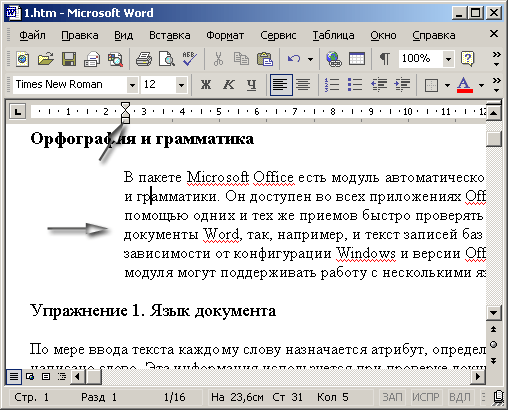
Figure: 6.2. Set up indents in Word
12. Click the button Center toolbars Formatting.

Figure: 6.3. Alignment modes

Figure: 6.4. Paragraph Options dialog box in Word
13. Select the third paragraph and click on the button Right edge the same toolbar.
14. Click on the fourth paragraph and then on the button By width... The first four paragraphs of text now demonstrate four modes of text alignment (Figure 6.3).
15. Select the second, third and fourth paragraphs and choose the command Format\u003e Paragraph... Tab Indents and spacing of the opened dialog window (Fig. 6.4) allows you to set paragraph indents and alignment mode, which we configured using the horizontal ruler and toolbar buttons Formatting... Section Interval the same tab allows you to set the spacing between lines within a paragraph and the spacing between paragraphs.
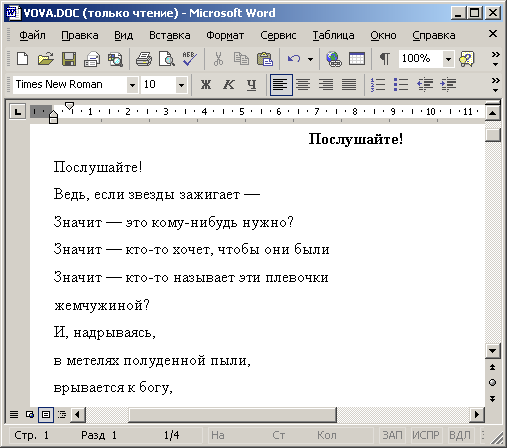
Figure: 6.5. Adjust spacing in Word
16. Enter 6 in front of the counter.
17. In the Interline list, select One and a half (1.5 tines).
18. Click the button OK... The spacing in the three selected paragraphs will change to match the spacing shown in Fig. 6.5. Please note that the area Sample dialog boxes Paragraph allows you to observe the effect of the entered values \u200b\u200bon the appearance of the current paragraph even before the final application of the selected parameter values \u200b\u200bto the text of the document.
19. Save the document for use in the following exercises.
The red line is familiar to us from school. And if earlier we measured it with the size of our fingers, now Word successfully does it, and we only command it how far the paragraph line should be moved.
How to indent paragraph in Word 2007
- If you need to shift the entire paragraph to the left or to the right, and not one line, we find the "Paragraph" section on the toolbar on the "Main" section, select the Decrease Indent "or" Increase Indent "button, respectively. In this case, the cursor should be on the "movable" paragraph.
- You can adjust the indentation of the red line by right-clicking the window in which you should select the "Paragraph" line (or click on the lower right corner of the "Paragraph" section on the top panel). You will open a menu in which you can set the settings not only for the first line, but also for all indents in the document.
- If you put the cursor at the beginning of the line and press "Tab" on the keyboard, the line will automatically move to the right.
- You can adjust the indents of the red line using the sliders at the top of the page; for this, you must first select the text. If the sliders are not visible, you should go to the "View" tab - the "Show or hide" section - check the "Ruler" box.
Indent in Word 2003
- Select the text to be formatted, with the right mouse button select the "Paragraph" from the list, in the "Indents" section set the required spacing in the "First line" field. Or make the appropriate settings by going to "Format" on the toolbar - subsection "Paragraph".
- You can also adjust the indents with the slider at the top of the page, which is called by the "View" tab - the "Ruler" section. Select the formatted text.

With this minimal effort, you achieve the necessary text formatting in the paragraph indentation area.
Conquer Word and see you soon!
In Word, you can use several ways to separate paragraphs. For example, indent the beginning of the first line of each paragraph.
I have seen how those who do not know how to work in Word suffer with paragraph indents. I bet that you press the Tab key at the beginning of each paragraph. Of course, this is unprofessional, but you are forgiven - you are just learning. So remember: Word will indent the paragraph itself - automatically!
In the following sections, we'll look at several options for paragraph indentation.
Auto indent the first line of a paragraph
No, no and NO! You don't have to touch the Tab key! Word will create the necessary indents itself. However, this requires the following steps to be performed first.
- Choose the Format ›Paragraph command.
A dialog box will appear Paragraph... Click on the tab tab Indents and spacing (fig.12.2).
- Open the First Row list.
You will find it on the right side of the area Indent dialog box.
- Select Indent from the First Line list.
- In the By field, specify the amount of indentation.
If you're not confused, this field defaults to 1.27 cm. This means Word will shift the first line of each paragraph half an inch from the left margin. In this case, measurements are made in centimeters (or inches - it depends on the settings of your computer), not in points.
- Click the OK button.
The selected text or the current paragraph (in which the cursor is positioned), as well as all subsequent paragraphs on the first line will have paragraph indent.
To undo indentation, follow the same steps, but in the list First line select item ( Not). Click on the button OK.
There are two ways in Word to separate paragraphs. First, you can increase the white space after the paragraph, as described in the previous section. The second way is not to increase the spacing between paragraphs, but to indent at the beginning of the first line of each paragraph.
How to create a hanging indent
Dangling indentation has nothing to do with an unsolved crime. This is an indent, in which only the first line begins in the usual way from the left margin, and all the rest are indented, - the paragraph seems to have grabbed onto the edge of the page with the left hand. For example, I formatted the following text this way.
Stain remover "Surprise... New laundry detergent that doesn't remove stains, smells bad and pollutes the environment. But everything is fair! For wealthy clients. (When ordering more than 10 packs - 8% extra charge.)
To get such a paragraph, do the following.
- Place the cursor in the paragraph where you want to set the hanging indent.
You can also position the cursor at the point where you want the new hanging indentation paragraph to start. (You can select a block of text.)
- Click CTRL + T, a keyboard shortcut for the Outstroke command.
CTRL + T moves the entire paragraph to the first tab stop, leaving the first line in place.
These actions can be performed using the dialog box Paragraph... In the list First line select item Ledge, in the By box, enter a value (usually half an inch - 1.27 cm). Click on the button OK!
- Rest assured, in a paragraph with a hanging indent, absolutely all lines will be shifted except for the first one.
- If you want to increase the indentation, press the keys CTRL + T repeatedly.
- It's strange that Word provides a keyboard shortcut for creating a hanging indent, but there is no shortcut for indenting the first line. The latter, it seems to me, is much more common.
- To undo the hanging indent, click CTRL + SHIFT + T... This keyboard shortcut will quickly make your paragraph hold hands at the seams.
A document is easier to read and better visually perceived if the text is divided into paragraphs and is indented by the first line. When typing on a computer using the Word interface, there is no need to repeatedly press a space at the beginning of each paragraph. There are several ways to indent, each with its own advantages.
Key
The easiest way to make a paragraph in a Word is using the key
Adjustment by eye under the ruler
In Word 2003, 2007 and 2010, you can make a paragraph by eye. To do this, you need to use the horizontal ruler at the top of the page. If the ruler is absent, in the "View" menu tab, put a tick opposite the "Ruler" command.
There are two ways to customize a paragraph with a ruler:
- Select editable paragraphs. On the horizontal ruler, move the cursor to the small triangle at the top of the "First line indent", click on it with the left mouse button and, while holding, drag to the desired location.
- At the intersection of the horizontal and vertical rulers, find the tab stop indicator (square) and click on it until the "First line indent" icon appears inside. Next, click on the horizontal ruler where the first line of the paragraph should begin.
Fine-tuning via the Paragraph dialog box
To fine-tune the indentation, use the "Paragraph" window. First of all, you need to select the paragraphs for which the indentation parameter is set, and right-click on the selected fragment. Select "Paragraph" in the appeared context menu.
In the "Indents and spacing" tab, find the "Indent" group, and in it the "First line" column. In the drop-down menu, select "Offset", and in the "on" box, specify the value in centimeters. The default indentation is 1.25 cm.
In Word 2010, the Paragraph dialog box can also be invoked by clicking the menu on the Home tab, and then, in the Paragraph group, the square with an arrow in the lower-right corner. Then proceed as described above.
Visual perception is an important component when working with any kind of information, including text. Visual memory "works" more efficiently when clearly structured text is in front of your eyes.
The most common and popular text editor is MS Word. Exactly this application is used by the lion's share of users when it is necessary to prepare any text Document... One of the essential attributes of formatted text is indentation. Competently placed paragraphs will help not only improve the visual perception of information, but also highlight the semantic blocks for a better understanding of the content of the document.
How to make a paragraph in a Word: the ruler and its markers
One of the tools of the MS Word editor, which is actively used when creating paragraph indents, is the ruler. This attribute is located above and to the left of the main field of the document. If you don't see the Ruler, check:
- Is the page layout mode set? If not, turn it on.
- Whether the Ruler option is enabled. To do this, go to the "View" tab and in the "Show" section check the box next to the "Ruler" field.
As for the attribute itself, it is represented by 4 markers. 3 of them are located on the left side, 1 - on the right.
- Bottom-left marker - will indent the entire text (or its fragment) without selecting the first line.
- Middle marker - will indent (shift to the right) for the entire block except for the first line of text.
- Top marker - to style a paragraph in the text. Will indent only the first line - red line.
- The lower right marker is used to set the amount of indentation to the right (distance to the right margin).
Before starting to edit the text, decide what kind of indentation you need and what its size will be. Next, you start formatting.
How to make a paragraph in a Word: paragraph indent on the left side
There are several ways to create this indentation.
Ruler
- Place the mouse cursor in the fragment in which you need to select the red line or select the entire text (Ctrl + A).
- Moving the bottom marker, set the required indent size.
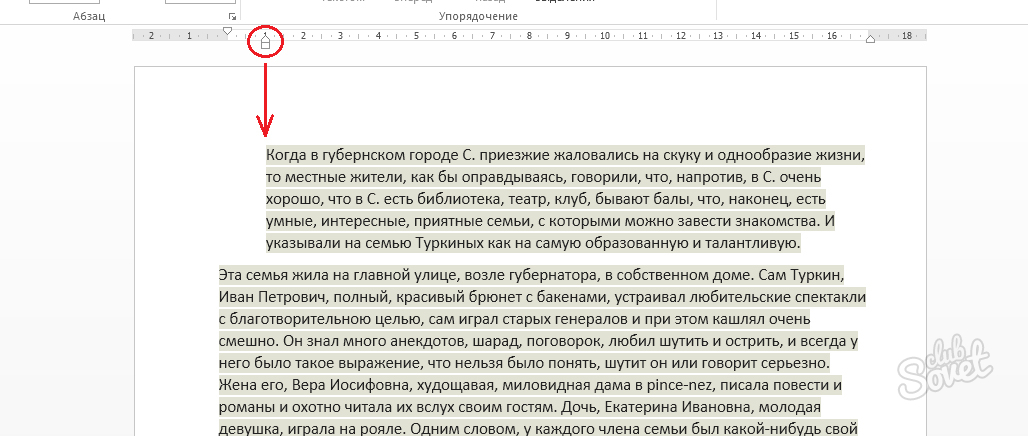
MS Word menu
- Select part of the text that requires indentation, or the entire document.
- Go to the document menu: "Page Layout" - "Paragraph" and click the icon in the corner with the arrow.
- Set the desired parameters for the left margin (the distance is measured from the set left margin).
- Click "Ok".
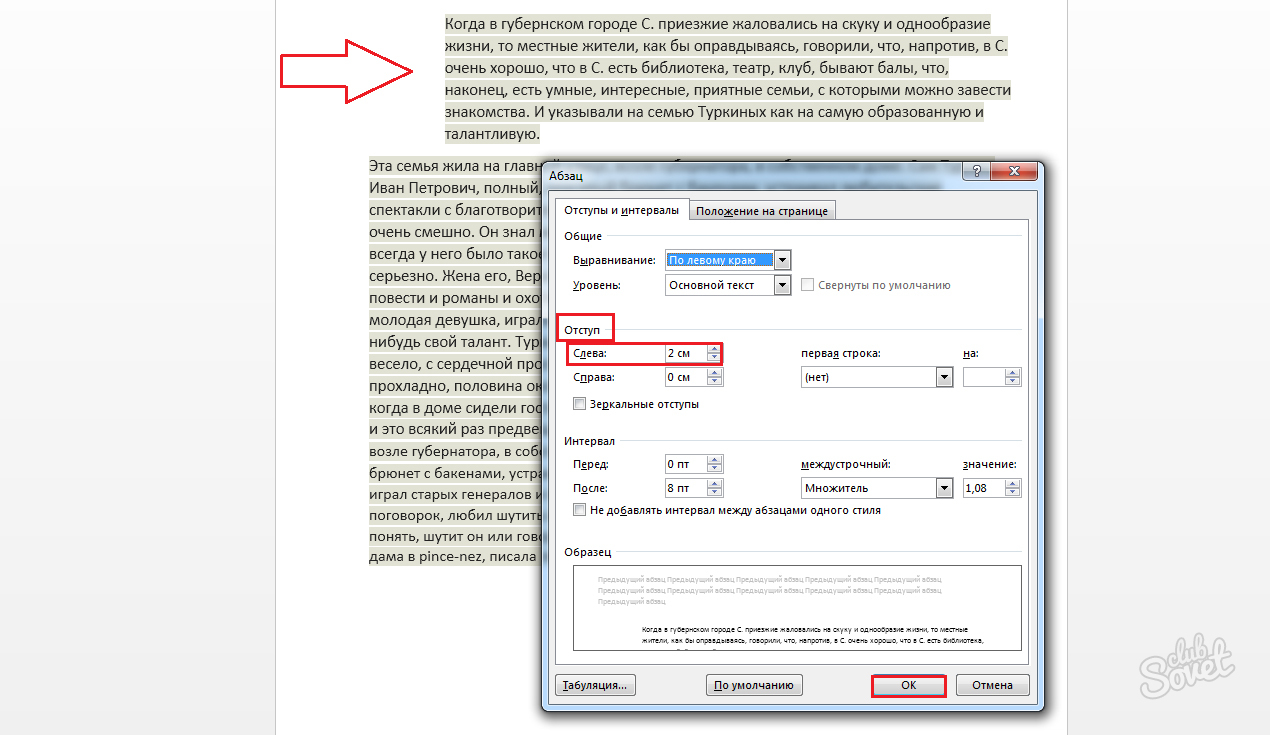
How to make a paragraph in a Word: paragraph indent on the right side
In addition to the traditional left indentation, you may need to indent the right side as you format your text.
- Select a document (pressing Ctrl + A) or part of it.
- Go to the "Paragraph" section of the "Page Layout" tab and click the arrow icon in the square (in the lower right corner).
- Set the required number of cm in the "Right margin" field.
Another way to set the right margin is to refer to the bottom right marker on the Ruler and place it where you want it. By setting the right and left margins at the same time, you can achieve the desired location of the text fragment (in the center, with a shift to the left or right).
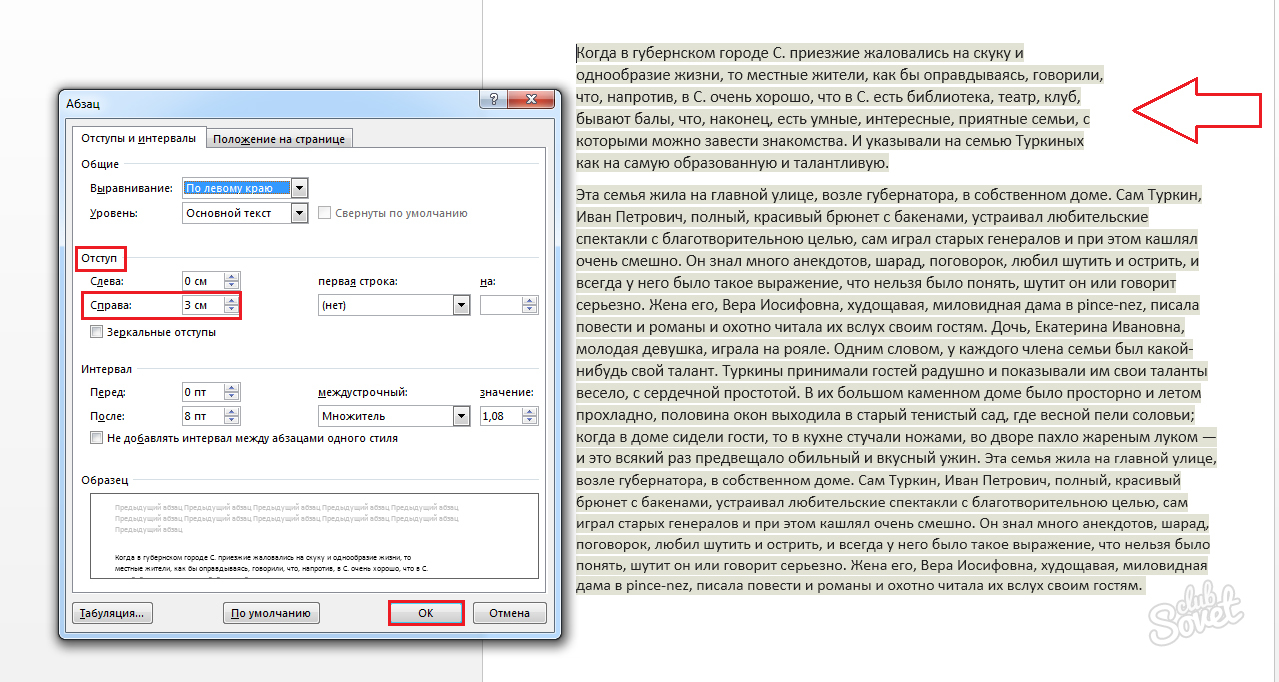
How to make a paragraph in a Word: red line
To highlight the next logical block of your document, it is rational to use the "red line". This term implies the formation of an indent (or ledge) exclusively for the first line of a semantic fragment.
- If the user works with the "Ruler" - you need to turn to the top marker and move it to the left - to create a protrusion or to the right - to create a paragraph.
- Or go to the "Page Layout" tab and in the "Paragraph" block click on the arrow icon. In the "Red line" field, set the type of indentation (protrusion or paragraph) and its value.
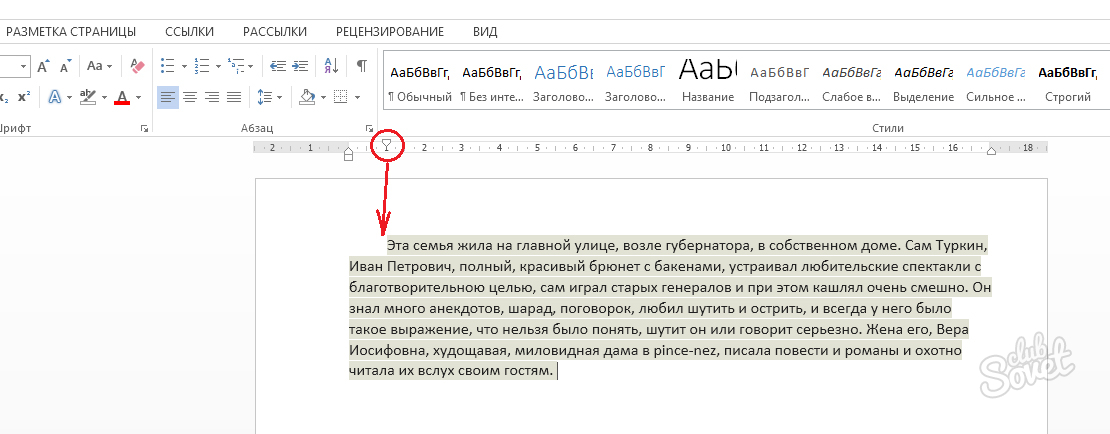
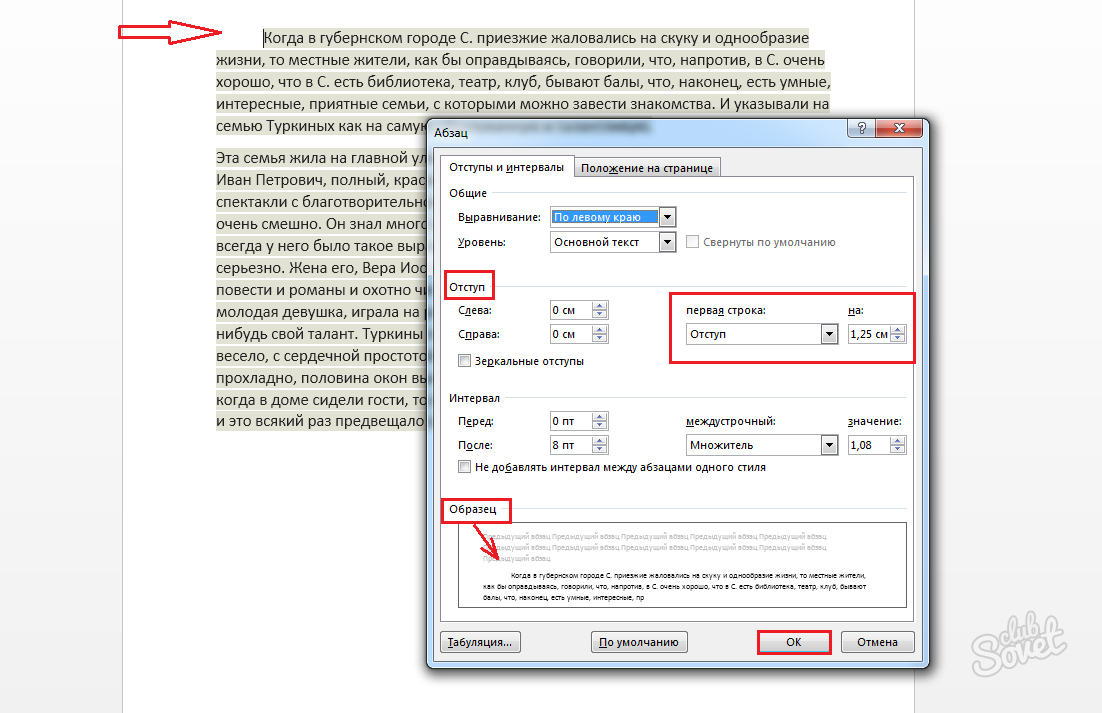
How to make a paragraph in a Word: mirrored indents
This option is especially useful when printing a document in the "Book" format.
- Select text or a fragment of it.
- Go to "Page Layout" - "Paragraph" - "Arrow Icon".
- In the formatting window, set the values \u200b\u200bfor indents (left and right) and mark the field "Mirror margins".
- Left and right padding options will change to "Inside" and "Outside" padding.
- Press the "OK" key to apply the specified changes to the text.
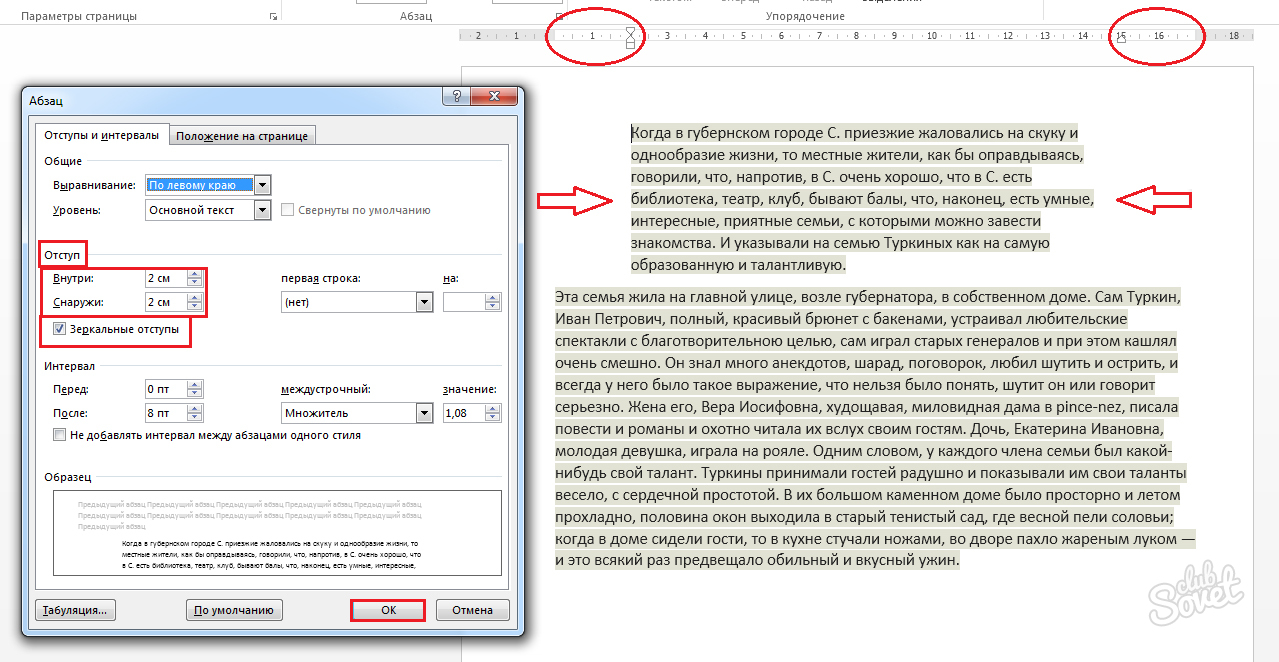
If you want your text to be interesting and understandable, make a correctly designed and competent document.